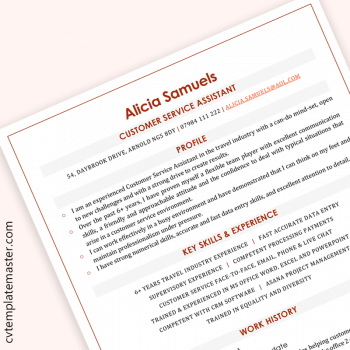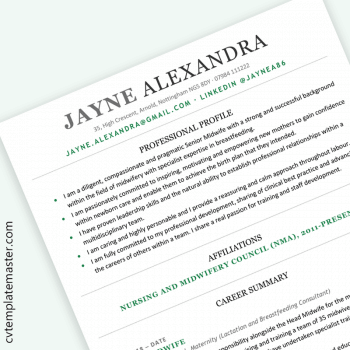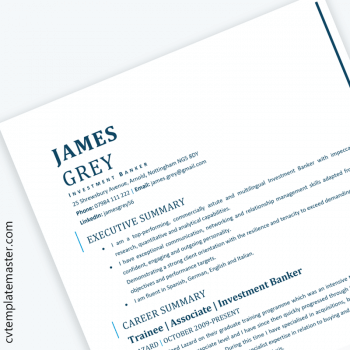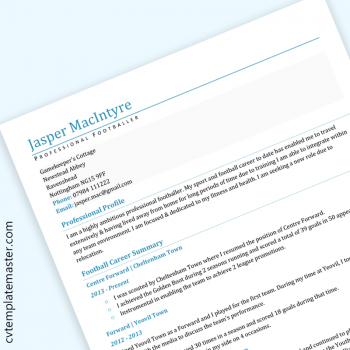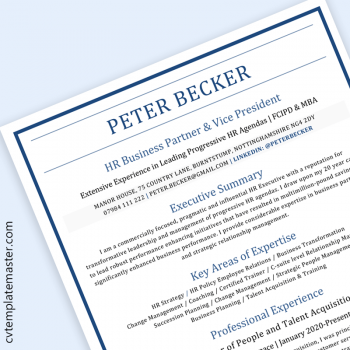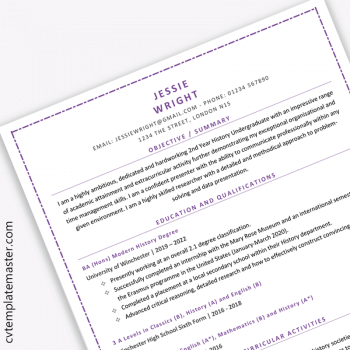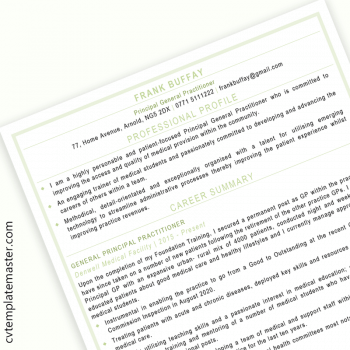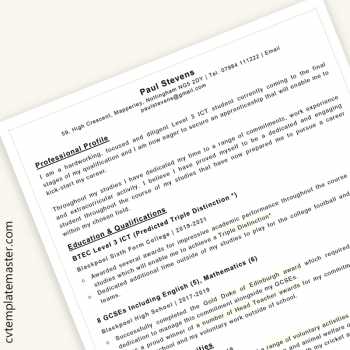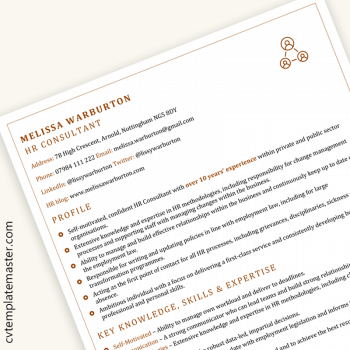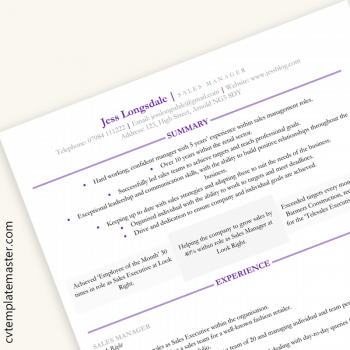What is a résumé, and how is it different to a CV?
A résumé is a brief one page document intended to catch the potential employer’s eye immediately and to stand out from the crowd. Résumé’s are designed to only show relevant information to the role which is being applied, whereas a CV will typically also show all of the potential candidate’s previous career and education history.
A CV will typically be 2-3 pages long and will contain a full list of achievements and qualifications, as well as hobbies and interests. CV’s also document the person’s complete career in chronological order, and will typical list tasks performed and responsibilities.
In contrast, the résumé is a brief one page statement which is purposely written for the job which is being applied for. The main focus of a résumé is for it to be quick and easy to read, but will also catch the employer’s attention so it can be put on the interview pile.
Customising your résumé
If you are wanting to stand out from the rest of the applicants and tailor the application specifically to the role you are applying for, then a résumé is a great way to do that and gain an interview. So how do you customise our résumé templates? Do your research and find out what your prospective employer is looking for. If you are unsure of the specific duties to be performed in the role you are applying for, then don’t hesitate to contact the employer and find out. It will also be really helpful to know the particular qualifications and skills which are required, so you can amend the résumé to showcase yours and point out how suitable you are for the role.
Aside from landing you an interview, your résumé will all act as a script for you and the potential employer, so it’s vital that when creating the initial résumé you highlight the relevant parts. You must also be prepared to discuss further anything from the résumé, so make sure you prepare responses before the interview so it goes smoothly.
What should be included on the résumé?
This may vary from role to role but an effective résumé will typically contain the following:
A heading: Your name, address and contact details including e-mail should be displayed boldly at the very top of the page.
Summary and objectives: When writing a summary you should highlight your previous experience and achievements, but try to keep it short and concise. Just 2-3 sentences will be fine. Make it clear what type of job you are looking for and what you are able to offer to the employer.
If you decide to write an objective instead, make it quite broad so it will cover closely related positions. But be careful not to be too broad as it could appear that you are unfocused. Again, on 2-3 sentences at the most will be fine.
Whether or not you choose to write a summary or objective, make sure you highlight the position, level and industry you are looking for. Also use your cover letter to make your objective or summary specific to the position. Tailoring the objective section each time you apply for a role can be an extremely effective way of landing an interview.
Previous experience: Here is where you can showcase and highlight your major responsibilities and achievements. This could range from any systems or processes that you’ve improved upon or even created. Or there may be some savings you’ve contributed to that are worth a mention.
Your achievements should highlight your career direction and focus upon any recent successes.
Skills: Here you can list all of your skills. For example, operation of specialist equipment or vehicles, IT skills, etc.
Education and qualifications: Ensure you put your highest degree at the start, and include the name and location of the school, college or University. Followed by anything else which relates to the position or career.
Publications, licenses, certifications: You only need to include anything here if it relates to your chosen career path.
Additional information: If you have an affiliation or membership which is again career related, then this can go here.
Résumé templates customisation tips
When you’ve downloaded your choice from our résumé templates, you might want to customise the look and feel a little bit more. This video will show you how to add a stylish border to one of our résumé templates – and adjust the size, colour and style to get the exact look that you want.
If you’d like to add a picture of yourself to your résumé, this quick video will show you how:
Other ways you might want to customise our résumé templates
There are plenty of other ways you can customise your résumé template to make it more personal to you. For example:
- Create your own style of bullets.
- Find a special font for the headings.
- Change the colour of the headings.
- Change the font for the main text.
- Change the alignment of the headings, your personal information or any of the sections.
Not sure how to put our résumé templates together? Try our guide on how to write a résumé.
Additional help with our résumé templates
If you need further help or advice customising our résumé templates, check out the articles on our site on writing your résumé and cover letter. These websites are also very useful for jobseekers, offering help and tips to give you the best possible chance of securing your dream job:
National Careers Service – this site is great for those who aren’t entirely sure how they want their career to develop. It’s got a huge selection of job profiles (over 700) to give you inspiration, together with CV advice and help for those dealing with redundancy, an increasingly common issue in today’s employment marketplace.
Prospects – Prospects is another great site for school leavers who aren’t entirely sure which direction they want to go in. As well as CV advice, you’ll find interview tips and a heads up on the best places to discover vacancies.
What now?
Once you’ve chosen your perfect résumé template and customised it, the process of hunting down your dream job can begin. But is applying for a job online the best way?
In today’s social media world you would assume that applying for a job online is the best way to get an interview. But this isn’t always the case! Although searching for a job online is the easiest and quickest way to find something suitable, your career is much more important than just clicking buttons – and here’s why.
Your résumé won’t stand out online
Even if you’ve got the smartest résumé template in the world, applying for roles online can make it difficult to be noticed. When you apply online and effectively send your résumé electronically to the employer, you could literally be up against hundreds of other applications all going through the same system. In some cases, maybe even thousands!
Although an online application is the fastest and easiest way to apply for a job, it doesn’t automatically guarantee you an interview – and in many cases you will never hear from them at all.
Ultimately, unless you have a friend working at the organisation that can walk your résumé straight to the hiring manager, then you are going to struggle to get results. Sure, your fantastic qualifications, skills and previous work history and experience may certainly get you to the front of the queue. But there could be fifty other people who are also perfect for the job.
It may also be that you are not completely qualified for the role, and you don’t have any previous experience in that particular industry or position. Even so, you are 100% sure that you would still do a fantastic job – and I’m sure you’re right!
But does the hiring manager know that? How can they if you don’t get chance to speak with them and prove your worth…
Quality keywords are vital
Another issue many people struggle with when customising their résumé template is the use of correct keywords. Computer tracking and filtering software for screening résumés and applications is becoming increasingly popular.
Take note of the keywords used to describe the role, and see how many match your own résumé. Make sure you tailor your résumé for the role if possible, or at least make it career orientated so it can easily be matched against the position. This is important not just so screening software filters you into the right box, but also because you want the employer to easily see how you are right for the job. Don’t make it hard for them!
Keywords are extremely important when it comes to crafting your résumé and if you are going to send applications online, then even more so if you want to stand any chance of avoiding the ‘no’ pile!
How can I ensure my résumé is seen and taken notice of?
Aside from choosing the perfect résumé template, to truly ensure your résumé stands any chance of being seen, you need to hand it in person to the hiring manager – or at the very least, someone who is going to take it to them for you.
A manager’s experience:
I’ve worked for many years in management, and have been responsible for screening applications and conducting interviews. I remember once when someone rang our office bell and asked to speak with me. I’d only been the manager for about 3 months and we were looking to recruit just one more person to the call centre.
I’d already received about 50 applications when the gentleman came to our offices to hand his résumé in person to me, as well as to talk about himself and the role. I wasn’t going to refuse to speak to him for a couple of reasons.
Firstly, I’m not a monster and like to think that I’m a good person – so for that reason alone I would always speak to someone who came to the office.
Secondly, if someone is going to spend the time and effort travelling to see me in person, then I am already impressed as well as curious to meet the person behind such boldness and confidence.
After speaking with him I decided to book him in for an interview later that week. Although his résumé wasn’t exactly what we were looking for and there were other applications which were better, he still had lots of experience and was very polite and friendly.
Above all else, I instantly got along with him and I felt that if he was to be hired, he would work well and get along with the rest of the team – something which you can’t find out by just reading a résumé!
After all of the interviews had been completed, it turned out he was the right person for the role and was successful. Had it not been for his visit to the office to hand his credentials in person to me, he would probably wouldn’t have reached the interview stage due to the sheer number of applications received – and which were better on paper.
